This May be the Only family website in the World where you will see More Documents, Proof, and evidence, Very Little or NO subjective or creative writing because Our documents speak for themselves.
Note: We could have Hired a Book writer, a film Producer, or a journalist very comfortably to make more Drama with lots of publicity. But it is not in our background. And Never needed because every document speaks for itself with a few lines. It is a matter of your sense, your logic. Your Judgment. I don’t want our golden truth to be polluted.
All with proper documentation and supporting documentation and Photos at the bottom.
During World War II, Japanese forces invaded Burma (now Myanmar), which was then under British colonial rule. The British forces retreated, and in the power vacuum left behind, considerable violence erupted between pro-Japanese Buddhist Rakhine and pro-British Rohingya Muslim villagers—Indians stuck between.
“Jaan Bachi To Lakho Paya” If you survived in Killing, you earned millions.
My father ran the 32,000-acre rice mill In Pyapon village with six hundred Helpers staff from Udia, Bihar, Tamils, Rohingya Muslims, and Myanmarans; he treated them respectfully, nurtured them well, and looked after their children and family very well.
My father’s Mill had one weighing scale for Buying and selling. whereas most of the other mills had two scales, one for buying and one for selling.“That honest business goodness spread so fast to local communities, and people from far away started to come to weigh their rice on our scale before selling or purchasing it from another mill. My father’s Weighing scale became “Bhagwano kata,” Sacale of god. this simple Humanity helped us to save from getting killed by the other 50–60 thousand Indians. around neighboring villages,5000–6000 Indians and Muslims, including us, were able to survive thanks to Local Myanmar. we were able to escape in the night, leaving Mills to looters and killers. you will read further here. we were Protected by Local Burmese (Myanmar) People, who cordoned off our home and stopped Myanmaran Buddhist Killers with” Dhav,” some kind of sword, for the next 6 days.
Massacre of Indians, British Pathe
Arakan Massacre, Wikipedia
Rohingya people, Wikipedia
The Indian Exodus, Scroll.in
British Burma, University of Central Arkansas
India’s Rangoon Connection, Indian Express
Dunkirk of the Easy, The Independent
https://www.nbcnews.com/id/wbna49786092 The hate injected by the British is still active even after 60 years


Two Heroes of humanity in the 1900s. Manilal Nautam all Mehta ( Fiya Babbu) and his brother Vaju Nautamlal Mehta both Brothers At the cost of their life, millions $ with their Mill to save Hindus and Muslims from Burmees Mob in the 1942 march. 2nd world war.
To Save six Rohingya Muslims from the local Burmese mob attacks cost my father millions when his mill was looted in Burma (Myanmar) in March 1942. They also saved over 5,009 Hindus and Muslims by protecting them for five days from death.
My father, Manilal, and Uncle Vajubhai, their humanity was at its best. They saved over 5,000 Indians by protecting them for five days from death by Burmese hands. Read about their life-threatening moments in my father’s handwritten 12 pages letter to his father, Nautamlal Bhagawanji Mehta, of Jetpur,
Why does this Hate ONLY toward Indians? The British were governing Burma. However, most Burmese and Chinese did not match the abilities of Indians; therefore, in the late British 1800 century, the British started collaborating with Indians in Burma. However, the British failed to understand that there were no locals, Thakor, Raja, and Maharaja. Who could act as a British agent to control the local Indians? In Burma, it was difficult for the British to control Indian growth and prosperity.. Therefore, they started dividing and ruling between the Burmese (Buddhists) and the Indians (Hindus). Most of the Muslims were united with hindu indians.


Fiya Babu Manilal Nautamlal Mehta is in the center with his Mill helpers. right side Picture Mahatma Gandhi and Pandit Nehru visited this Mill
Spreading the air of hate that “Indians were looting Burmese ” and taking away their jobs” was the seed of hatred that grew bigger until the 2nd world war. The British lost to Japan and had to flee. The country was lawless.
Thitan mill near Pyapon was on 3300 acres of land South West of Burma. Due to war and Lawlessness, No media and nonjournalists. It was a time of life and death — no post or telegram.
Saving six Rohingya Muslims from Burmese attacks cost my father millions when his mill was looted in Burma ( Myanmar) in 1942. Their humanity was at its best for my father, Manilal, and Uncle Vajubhai. They also saved over 5,000 Indians by protecting them for five days from death by Burmese hands. Read about their life-threatening moments in my father’s handwritten letter to his father, Nautamlal Bhagawanji Mehta, from Jetpur, Gujarat, where he shares how they preferred to give up their wealth in exchange for saving innocent Indians’ lives by providing shelter and safety from pro-Japanese, and Burmese. The Burmese people were looting and killing any Indian or Muslim. My father shares how he, my mother, and my uncle navigated and survived this horrific situation in a 12-page letter he wrote to my grandfather, Nautamlal. Thanks to modern technology, the same note is now typed and may be easier to read and translate into any language.
Before you read my father’s letter, please spend 10–15 minutes on this link below so that you will understand the Life-threatening danger My Father Manilal and His Brother Vaju Bhai faced for almost a week with Mind-boggling courage, Skill, and Diplomatic tactics to keep Killers, Looters at a distance and calm.
With their courage and Heroism, they exhibited to save thousands of Hindu- Muslims from the Burmese ( Myanmar) mob.
https://en.wikipedia.org/wiki/Arakan
Below, you will find links to published research papers and news articles to better understand the historical context of what was happening in Burma (Myanmar) at the time. The mill referenced below was in a small town named Titan, and the nearest big town was Pyapon. My parents’ rice mill had 700 employees on 3,300 acres of land. Per my father, 30,000–40,000 Indians were killed by the Burmese, and about 500,000 Indians had to escape back to India.
The mill mentioned in the letter was owned by my father, Manilal, and Pranjivan J. Mehta. This is the same mill visited by Mahatma Gandhi, Pandit Jawaharlal Nehru, and Indira Gandhi (check out the photo here).
For our English readers, my daughters, Anjali and Riddhi, son-in-law, Adam, and wife, Veena, spent days reading the letter and translating the context and feelings of the situation into English. We did have to interpret some of the town names or people in my father’s letter, which was written almost 80 years ago. Wherever we had difficulty interpreting, legibility or understanding a word in Burmese, we googled or left that space vacant for the future.
Without a gun or army, my parents and uncle’s primary weapon was their way of living. Their approach impacted the local Burmese so much that they used to call them “Phaya Babu” (translated to “God-like man”), and the locals did their best to protect them. The locals told my father they would not allow hooliganism or looters to enter the mill compound. Meanwhile, my father and uncle were negotiating with the looters’ demand through some unknown middlemen.
Finally, the looters said my father must give them 6 Rohingya Muslims they intended to kill. The Rohingya Muslims were putting their lives at my father’s mercy and hands. My father told the Rohingya people that the only option they had was for them to escape. Otherwise, everyone’s lives would be at risk. Then my father sent a letter to Mr. Mountbatton in Pyapon, who sent 4–6 security people with guns. In the middle of the night, the 6 Rohingyas, my parents, and my uncle escaped by walking through the jungle at midnight. By walking through the jungle at midnight instead, he was also alerted that the Burmese were ready to kill everyone in the mill, so he sent a message to a Buddhist monk who helped the remaining people escape. Once my family was exhibited in Pyapon, they had safety and better law and order.
The following day, the local looters found out the mill compound was empty, and they looted the mill for the next three months, selling our product supply, machinery, and whatever else they found locally and in Rangoon (Yangon).
My father wrote this letter to his father, Nautamlal, on March 21, 1942. My grandfather didn’t receive this letter until late 1944. Only God knows my grandfather’s joy and peace when he received this letter. This same letter was circulated amongst close family members and finally ended up in Mumbai at the home of Nautamlal’s younger brother, Chimanlal Mehta. Then, in 1981, when I got married, Chimanla bhai’s son, Dr. Vasubhai Mehta, gave me these 12 pages and a cricket bat as a marriage gift — the most incredible gift was the letter.
Per my father, whatever photos and documents you see may only be 1% of what we had. They lost almost everything when they were looted on March 6, 1942.
Many historical stories from that time have yet to be told due to limited world press and the ban on mailing letters.
My Father’s Handwritten Gujarati 12 Pages Letter translated into English is the link below. You may translate into any world language at Google Translate.
Before you read my father’s letter, please spend 10–15 minutes on the below links (resource section) which are research papers and news articles to give you the historical context and understand the life threatening danger my father and his brother, Vajubhai, faced for almost a week. The mill that is referenced in the letter was in a small town, named Thitan, and the nearest big town was Pyapon. My parents’ rice mill had 700 employees on 3,300 acres of land. Per my father, 30,000–40,000 Indians were killed by the Burmese and about 500,000 Indians had to escape back to India.
I read about their life-threatening moments in my father’s handwritten letter to his father, Nautamlal Bhagawanji Mehta, from Jetpur, Gujarat, on March 6, 1942. He recounts how he, his wife Sharda Manilal Mehta, and his brother Vaju Nautamlal Mehta escaped Burmese attackers during World War II. This is the first letter Nautamlal Bhagvanji Mehta received from his son in three years since World War II started in 1939.
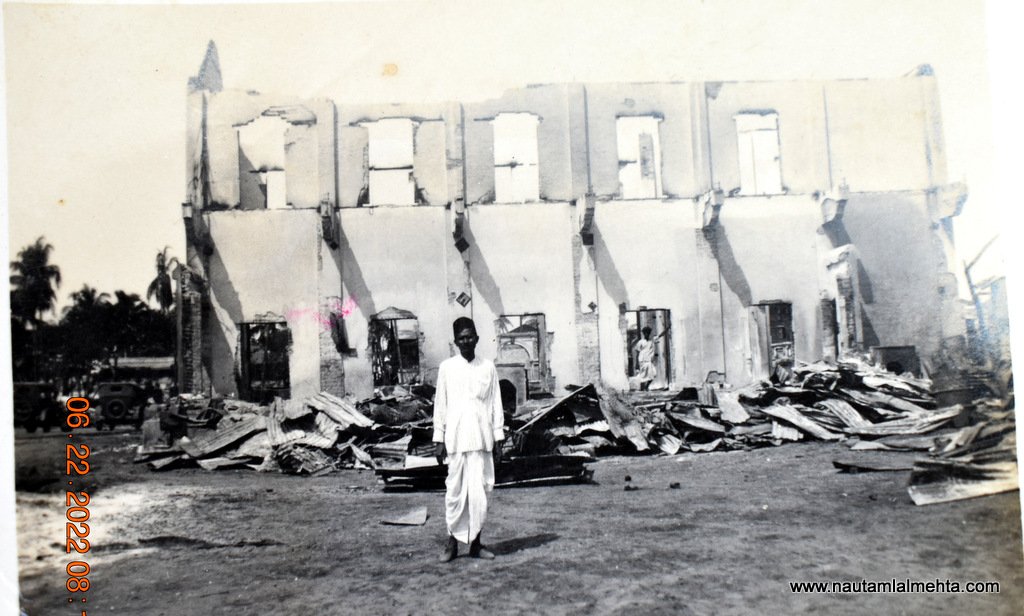

Thitan Rice Mill near Pyapon (Burma/Myanmar) is a 3300-acre land mill jointly owned by Manilal Nautamlalal Mehta and Dr. P.J. Mehta in the aftermath.
Resources
Massacre of Indians, British Pathe
Arakan Massacre, Wikipedia
Rohingya people, Wikipedia
The Indian Exodus, Scroll.in
British Burma, University of Central Arkansas
India’s Rangoon Connection, Indian Express
Dunkirk of the Easy, The Independent
https://www.nbcnews.com/id/wbna49786092 the Hate injected by the British is still active even after 60 years
This Below Letter of 12 Pages was written in Gujarati to Manilal’s Father Nautamlal B Mehta, on full details of the Loot and killing. Later was dated March. 6, 1942

The contents of the letter Translated in English state:
The looting started on March 2, 1942, in the evening. We left the mill on March 6, 1942, to save our lives (and moved to the house), and then arrived in Pyapon soon thereafter. Since then, we have been living in Pyapon. Our health is fine. We have no serious illness or injury.
Other than the security staff, there is no one else left at the mill besides the old staff. Until March 1, 1942, the mill was being operated properly by the old staff. And on our farmland, the Odiya workers were safe. Around February 28, divisional police left Pyapon, and the atmosphere became tense and fearsome. Near Bhogle, there was fire looting, and the killing started (the murdering of Hindus and the unfortunate started. I use the word unfortunate because they never left for their motherland, India). On March 2, in the evening, all we saw was fire, fire, fire all around us. At night, lots of Hindus started gathering in our mill. In their minds, they hoped that in Babu’s mill they would find safety and shelter. In our farm, our farmers rushed to the mill with whatever clothes they had and gave us news that near Bhogle there are 2,000 to 5,000 Burmese people with swords and guns advancing. Local Burmese have also joined them. Together, they are moving forward and killing kalas (a derogatory term for Indians). They burned our shed and crops. The crop silos were also burned. Some buffalo were burned and others ran away.
During the night, in the mill, 1,500 to 2,000 Indians gathered for safety. By the morning, our worry, our pain, and our troubles increased. By the minute, the number of Indians increased in the mill. From five, ten, fifteen miles away, to save their own precious lives, men, women, brothers, girls, boys, old people, sick people, the breathless came running to save their lives.
How many sisters and brothers came to the mill crying. These sisters and brothers escaped the killing.
Page 2

Hearing their stories, we shivered in fear, we felt faint. In the land of Burma, where did God disappear to? This question kept disturbing me. People in the jungles, in small, or big villages, and farms were all killed. The Burmese are killing indiscriminately. The cruel hand does not see a small two year old flower-like child, or a 70 year old man, or a pregnant daughter, or a hungry person. They killed everyone. In the mill, 5,000–6,000 Indians had gathered. About 5 percent were injured or hurt. Vajubhai and I provided basic first aid, to the best of our ability. We wished to help a lot more than we could, but how could we help all these people?
The wounds were so deep that a doctor’s expertise was needed. We used reams of cloth as bandages. We gave each other courage and strength. Whoever lost their loved ones recently in the jungle, we gave them assurances and condolences. We gave rice and dal from the mill and our shop. How can we feed so many people?
The people were from Madras, Odiya, and Chatgaya, etc. We decided that if people had their own pots and pans, they could make their own food. For everyone else, they opened up their own communal kitchens for each community. We had plenty of water for everyone, but where do we find the dry wood for cooking?
In the mill, we did not have enough wood. By one or two rounds of cooking, all the wood we had was finished. We heard that the neighboring farm had more wood, so we decided to go there to get some. But going there would be dangerous — we risked the Burmese killing us. We mustered some courage and put together 2 to 4 ox-carts. Fortunately, nothing happened because the looters and the murderers were far away.
We gave these displaced people salt and tobacco. Tobacco is something these poor people are dependent on. Everyone was sleeping outside in the open. And there were so many people who had gathered here that in 10 acres of land, there was no space left to place a foot.
Wounded people keep coming and they feel relief and peace upon arriving. They felt that they had reached safety. They felt that no harm would fall upon them, but merciful God did not accept this. For the unfortunate Indians, their penance was not complete. I believe that the mill and I are very fortunate to be able to help these people in this catastrophe.
Page 3
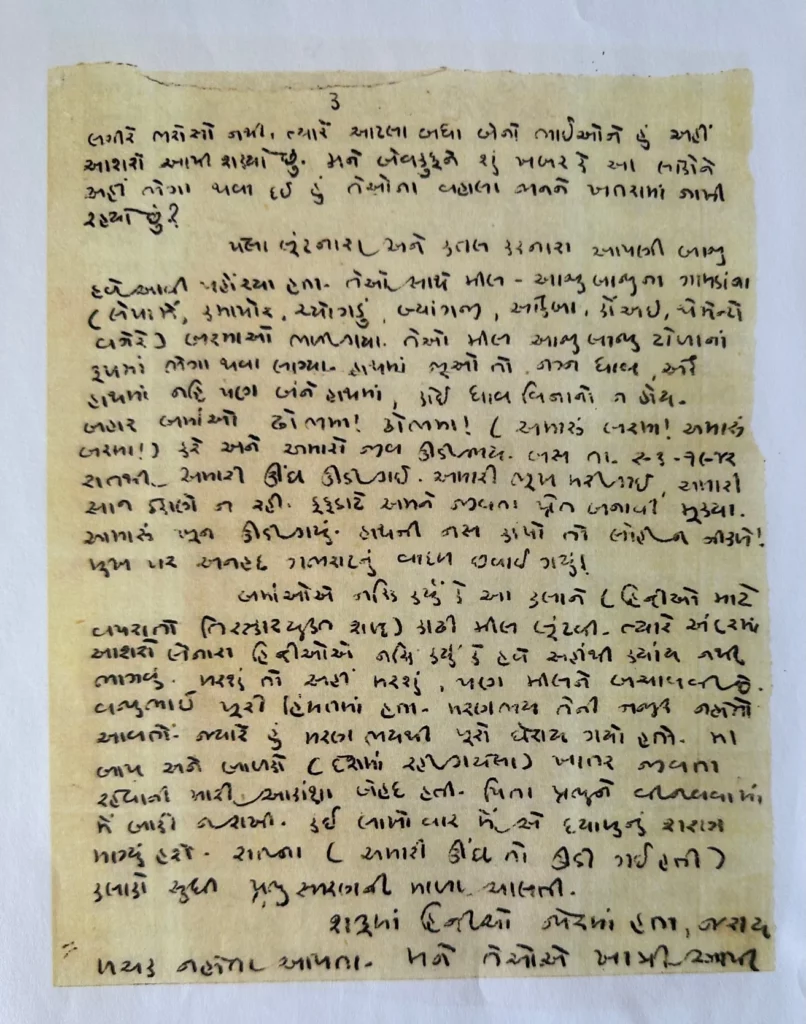
I do not have confidence that I am providing safety to these brothers and sisters — so many Indians in one place can make an easy target. How can a fool like me believe that gathering this many people in one place can save their precious lives?
Now the looters and murderers have almost arrived at our mill (these are people from Lepame, Kamamo, Rohingya, Byangaji, Akiba, Koye, Jomena, etc). They started assembling around the mill in groups. If you look at their hands, you will see a naked swords. Not in one hand, but both hands. Nobody is without a sword. Outside the mill, the groups of Burmese are shouting, “Our Burma! Our Burma!” And we got more anxious.
On March 2, 1942, we were awakened in the night. Our hunger was gone, our peace was shattered. We lived in fear and felt as though we were living ghosts. Our blood was gone. And if you cut our hand, there would be no blood. The cloud of fear is unbearable. The Burmese people decided that we will remove the kalas (Indians) and then loot the mill. At that point, the sheltered Indians in the mill decided that they would not flee from there and if they died, they would die there.
But, Vajubhai was very confident that we could save the mill. The fear of death was not near him, but I was clouded with that fear. My utmost desire was to live for my father, mother, and children who remained in India. We did not sleep and constantly prayed for life.
At the beginning, the sheltered Indians were in good spirits to fight the Burmese and did not want to give up an inch or flee.
Page 4

“Babu, please sit in the house peacefully. We will die, but we will not let the looters enter. We will see what happens next,” the Indians said. Vajubhai with a naked sword and Becharlal Patel with a loaded gun (we had a gun at the mill at the time). Because of my fear, I did not exit the area much at night. For protection, we collected broken branches, in the event we needed to fight. Throughout the day and night, we organized a security patrol.
The day and night of March 2 and 3 passed like this. On March 4, the day and night continued in worry. March 5 was the darkest day. If I try to write in detail what all transpired in these days, the letter would be 70 pages long. It is best if I tell you what happened in person. There were innocent and senseless killings by merciless Burmese. In these 2.5 days, some Burmese (who had offered us protection, possibly) let us down. The Burmese asked me for the mill and told us to leave. This is the first demand they gave. We agreed. But then after a few hours, they come back and demanded that the shop’s contents (worth about Rs. 60,000) also be distributed to the Burmese. We also agreed to this demand. We allowed for the store’s contents to be looted. To save everyone’s life, we were willing to forsake everything else.
After this, they came back and said that they had information that we had 3.5 lbs of gold and Rs. 1 lakh worth of jewelry. If we gave them all of this, then our lives would be saved. Where can I find what they are demanding? To give them trust, we decided to open up our safe to show them what we had.
Page 5
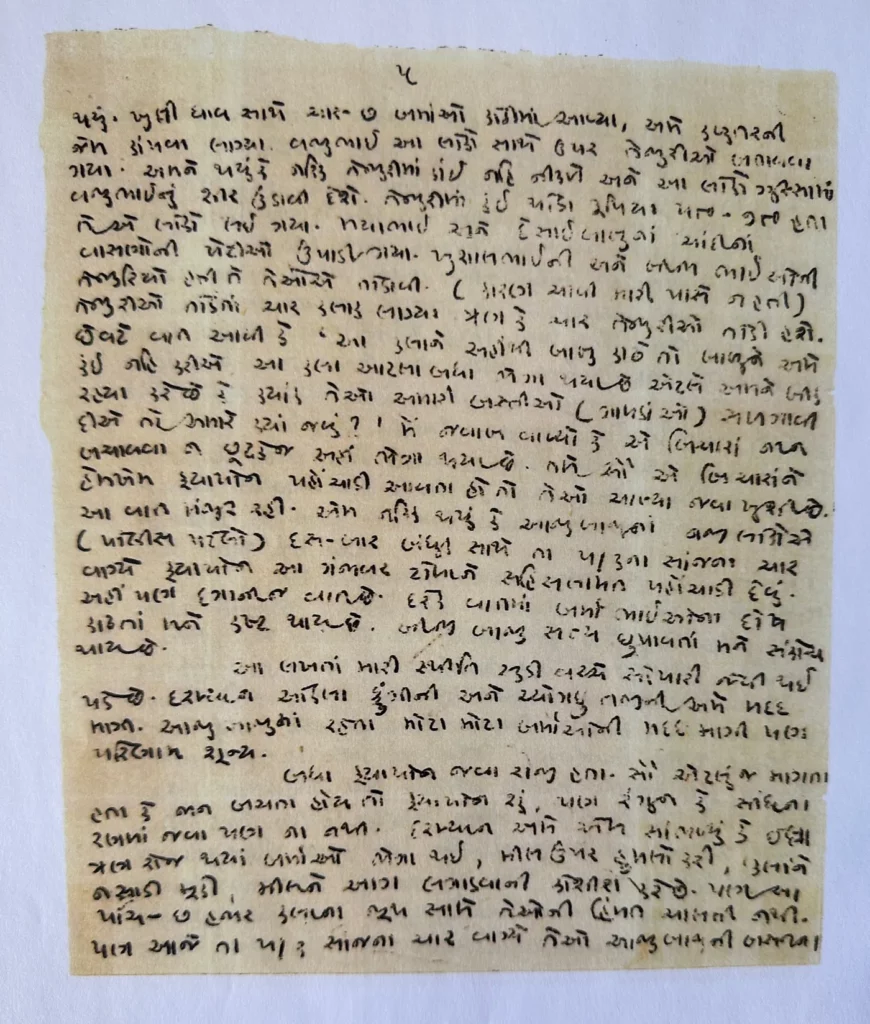
With unsheathed swords, 4 or 5 Burmese people came into the room with the safe. We shivered like pigeons and Vajubhai went to show them the safe upstairs. We thought that they will find an empty safe and in their anger will kill Vajubhai. In the safe, there was Rs. 5000–7000, which they took. They took Mayabhai and Desai Babu’s silver trunks. Kushalbhai and other brothers safe were broken into because I did not have the keys. It took them three to four hours to break into the safes. They must have broken into 3 to 4 safes. And finally, they offered, if we removed all the sheltered Indians from the mill, then we would all be safe.
They mentioned that with all these Indians together, we Indians could attack their Burmese villages. But I told them that these are people who are just trying to save their lives. If the Burmese would allow these Indians to go to Pyapon then they would be ready to go. They agreed. We decided that the neighboring people, who are considered police Patels, would escort the Indians who are willing to go to Pyapon. But the challenge remains — how do so many people make that journey?
For each issue, the Burmese were creating excuses and blaming Indians during negotiations to create more tension. While writing this, I am in a dilemma. I asked assistance from the Phungi (temple priest) and Thejnu Thagni. We asked for assistance from prominent Burmese who lived nearby. But the result was zero.
Everyone was happy to go to Pyapon. In order to save their life, they were happy to go to Pyapon, to Rangoon or even to the Desert of Sindh. Meanwhile, we heard a rumor that in three days the Burmese would gather, attack the mill, drive the Indians out, and try to burn down the mill. But with 5,000–6,000 Indians in a group, the Burmese are not confident in said plan.
Page 6

But by March 5, 4pm 1,000–2,000 neighboring Burmese people were planning to attack. I heard that some Burmese in Pyapon took a vow to come to our mill and loot it or to die. Our end is near. I am crowded with thoughts of our death. At 4pm in the evening, we were surrounded by the Burmese shouting “Our Burma, Our Burma”!
God Ram, the protector — the extremely moment has come. All together, 1,000 Burmese have come together, with 10 to 12 guns. At that moment, we were in the upper floor in a closed room. We were praying to our merciful god. The Burmese attackers got settled around the mill. We opened the window from the room to see. The moment we did, they fired. But the bullet hit the wall nearby and fell to the ground. We survived the first gun fire. But that attack created chaos among the other Indians and they started to run in any direction to try and escape. They felt that death was certain.
By running amidst all this chaos. Sisters, brothers, children, older people fell in the river and they swam to the banks. They tried to hide in the nearby bushes. Other sisters and brothers took to the road to Pyapon. There was no limit to fear. No one was acting with much sense.
We remained in the room. And a Phungi (temple priest) came. He took Vajubhai outside. And Vajubhai and the Phungi went to investigate whether the road to Pyapon was safe for Indians. We did not like how Vajubhai went out in this way, but his courage was mind-boggling.
Page 7

Becharbhai Patel came back and he told us that there were many Indians who were stuck on the Kanjana Bridge because on either side, the Burmese attackers were chopping off people’s heads, and throwing them into the river. Some dead bodies were on the ground. We were very worried about Vajubhai. We thought that these attackers must have killed Vajubhai. After some time, Vajubhai returned. Until then, we had no limit to the amount of worry and agony we suffered. Vajubhai shared unimaginable torture. Vajubhai saw our Indian brethren being killed and their heads chopped off. Vajubhai and the Phungi could not do anything to help. The attackers ripped children away from their mothers hips and threw them into the river. After chopping off people’s heads, there was still some life in the bodies and they threw them in the river.
On that day, in about one or two hours, just around our mill, we saw about 500 people lose their lives. About 50 of the mill’s workers and their children may have died. And then another 20–30 mill staff may have lost their lives. Some of the mill staff and engine staff had sought shelter in one of our mill’s small boats and they survived. Some mill staff, like some of the Odiya workers and Darwan (security guards) stayed with us and they too survived.
The Darwan and Odiya workers who left early, hid along the road to Pyapon and eventually survived. Other known colleagues of the mill, like Kanti Mami, who you know, also died. Saryu, who you also know, her father, brother, sister, mother, sister-in-law, and children were all killed. And Saryu was also killed. The mill’s two to three tailors were also killed.
There are others who died, but you do not know them. I have made one mistake, however. Earlier, I mistakenly wrote that the darkest day was on March 5. It was on March 4. After all this killing, the mill became barren and we lived in fear that if we left our room, we would be killed by sword.
Page 8

Once the mill’s looting started, the Odiya workers’ household items were also stolen and they were also killed. The attackers also tore down the doors of the shop, and they stole the food and the cloth reams. The Burmese attackers also took our boat, and two of our workers who were hiding in the boat were discovered and also killed. Their bodies were thrown into the river. We witnessed this all. What kind of sins did we commit in our past life that we have to see such agonizing destruction?
Madhevan Hirani left us on the first day of the looting and ran away. Madhevan’s brother and his family participated in looting the mill. Bhatao Hirani also ran away. His relatives also participated in the looting. Until the end, Potlilal and Engineer Komaye also looted the mill and kept what they stole in their home. The Burmese attackers still did not leave us alone even after stealing everything. Our karma from our past life and this life is still not over.
On March 3, from our room, some close colleagues of ours ran away. At night, someone mentioned that the Burmese attackers do not want Babu to give shelter to Chatgaya and other associates such as Ali Ahmed Malik and Abdul Malik in Tithan because the Burmese attackers have great anger towards the Chatgaya people. If Babu provides them shelter then they will kill us all.
Look at our moral dilemma. This situation was discussed with Doma privately. How can we tell our Chatgaya colleagues to leave and risk death, while they are seeking shelter from us? The Burmese attackers have no problem with the Chatgaya who worked in the mill, but they had a problem with the Chatgaya members who we were sheltering. We had no time to think about this properly.
With tears in my eyes, I went downstairs to meet with the Chatgaya members we were sheltering and told them the situation. They started crying and touching my feet. They had Rs. 200 to Rs. 400 and started giving me the money to give to the Burmese attackers so they would allow them to stay with us. They told me that “if we leave, we will surely die.” No one can give these Chatgaya refugees seeking shelter any guarantee of protection and so I just cried.
Page 9
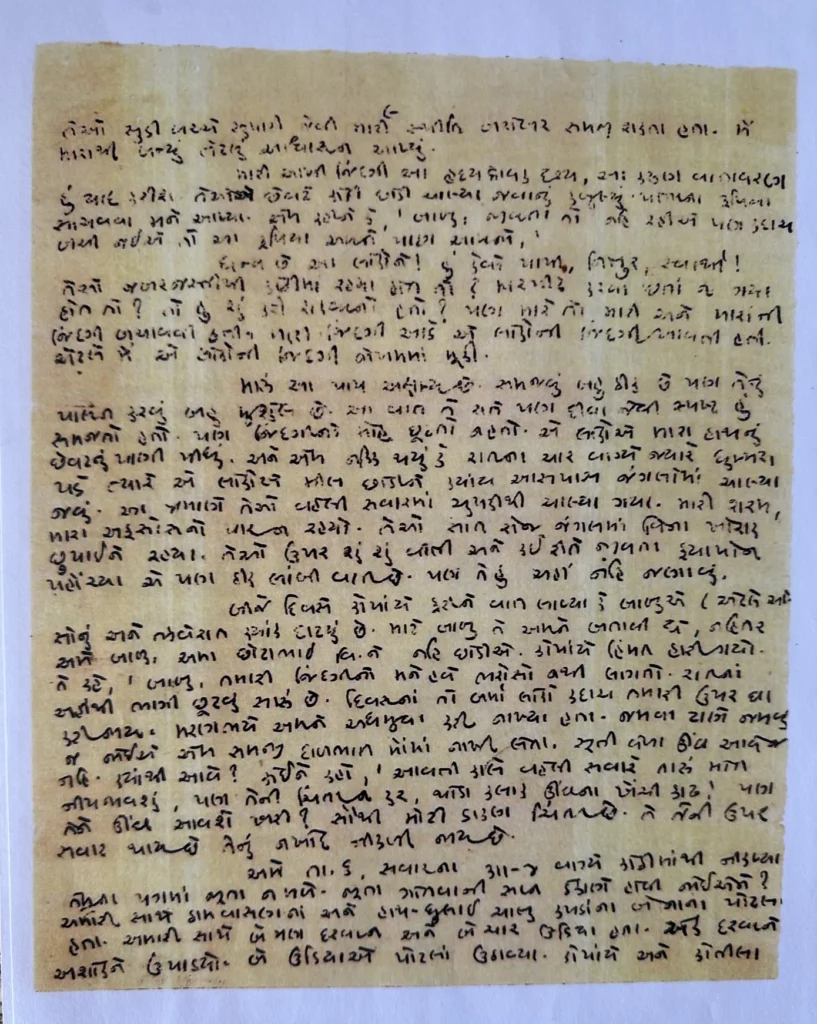
The Chatgaya people understood my dilemma — if they stayed, then the Burmese attackers would kill everyone. I tried my best to protect them. I expressed my sympathies. For the rest of my life, I will remember this situation as the most heartbreaking and painful moment. As they were preparing to leave our home, they gave me their money for safekeeping and told me, “Babu, we are unlikely to survive, but if we do survive, please return this money to us.”
Immense gratitude to these Chatgaya refugees. How bad am I, how sinful am I, how merciless am I, how selfish am I? If they had refused to leave, and if we had tried to force them to leave, then what would have happened? But I had to save my own life. Their life was an obstacle in my life. Therefore, I put their life in danger to protect my life.
This sin is unacceptable. To understand and accept this sin is very difficult. To respectfully implement this action is also very difficult. I used to think that every action is crystal clear. But the attachment to life disturbs all his clarity of understanding. I gave them some water to drink. As per their plan, they left in the early morning, at 4 am and headed quietly towards the neighboring jungle, amidst the fog. When they left, there was no limit to my shame and sorrow. They spent seven days in the jungle without food and hid. How they lived like this and reached Pyapon is another story that I will not write about here.
The next day, Kopa (our staff member) brought an issue again from our Burmese attackers. Kopa said, “Babu, you have hidden the gold and jewelry somewhere. Show me where it is. Otherwise, they will kill you and Vajubhai.” Kopa lost his courage and told me that “I don’t believe your life can be safe here, so you should consider escaping at night. During daylight, the Burmese will notice and attack you.” Fear has made us half-dead. During meal time, there is no desire to eat or drink. We just put a few morsels of food into our mouths. During the night, we cannot sleep. We just act as though we are sleeping. We were so fearful. It is like someone telling you that you are going to die tomorrow, then how can you sleep?
On March 6, in the morning, between 3:30 to 4am, we left our home. We could not find shoes. There was no time or mood to even look for our shoes. We took a few pots and pans and a few pairs of clothing in potlas. We had two Darwans (security guards) and two to four Odiya workers accompany us. One Darwan carried Ashok (our son), and two Odiya carried our potlas.
Page 10

When we left, our Darwan walked ahead of us with an unsheathed sword. I consider the mill more than my life, which I am leaving for good. I considered this mill as my child. I was involved in its progress, expansion, and prosperity. When it underwent a painful downturn, I cried for it. This is a very painful experience and I imagine for you too, and thus I do not want to write more about this and cause you more pain.
When we reached Okla Pongyi Chaun, it was still very early in the morning. From our mill, this Chaun is 1.5 miles away. The road was bad and was primarily farmland. The Pongyi (temple priests) have not been very cooperative, but today they were our potential saviors and thus, we were bowing before them. The people who were with us after leaving the koti were also grateful to the Pongyis. We all came together by the morning.
The mill became an orphan. In the mill, there was plenty of stock and valuable items. For the Rangoon Khadi Bhandhar, there was Rs. 30,000–40,000 worth of khadi. Other valuable items and goods of Mayabhai, Desaibabu, Kushalbhai, and other babus of Pyapon were also at the mill. Trunks of pots and pans, trunks of books, bedding, Singer sewing machines, and various types of furniture, cabinets, safes/vaults, etc. were all at the mill. In our goods, we were able to save my sister, Mayaben’s silver pots and pans and jewelry. And we could move some clothes and other items to another safe space. We were able to save only 30 ticals (16.4 gms of gold = 1 tical) of gold for the mortgage. After the looting, we were able to recover four to six accounting books from the mill.
From our belongings, we could save one trunk of clothes and jewelry. We had kept this trunk in another home and brought it back to the koti. In the koti, there was a Burmese neighbor who was very helpful. We were able to keep everything at the neighbor’s daughter’s house. This Burmese family has given us tremendous help and support. My sister’s jewelry, our gold jewelry, and the mill’s gold were saved only because we had this Burmese family’s assistance. This Burmese family sent our precious belongings to another family’s home — through this process, we could preserve and recover our belongings.
How we hid these belongings and brought these belongings to Pyapon is another story, which I will tell you in person.
Page 11
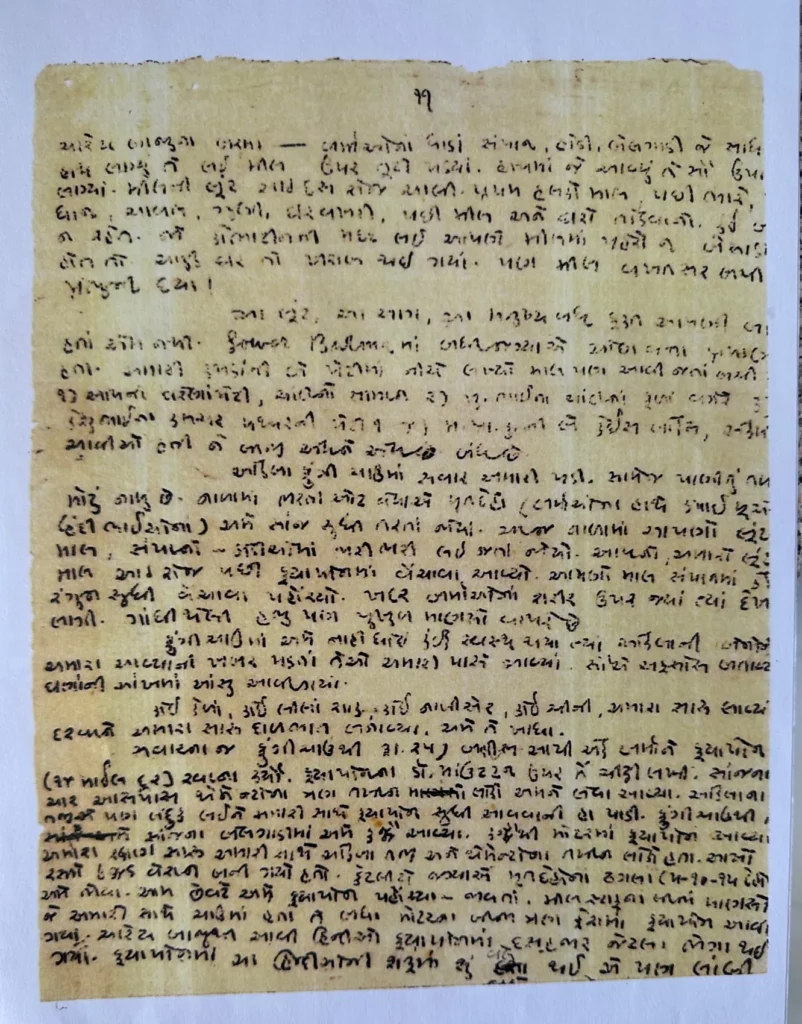
As we left the mill, in the same way, that vultures attack a dead body, from near and far, from all corners of the area, mobs of Burmese people, people in boats, and people with ox-carts started to steal whatever they could get their hands on and destroyed the mill. The looting continued for 8 to 10 days. First they took the light, movable goods. Then they took the heavier items like furniture and machinery. Later, they started tearing apart the building. The mill has no security or any help. But eventually, we were able to secure some security to help us save whatever was left of the mill — thanks to the help of God.
[the rest of page 11 requires reading from the original copy]
Page 12

[the rest of page 12 requires reading from the original copy]
Resources
Massacre of Indians, British Pathe
Arakan Massacre, Wikipedia
Rohingya people, Wikipedia
The Indian Exodus, Scroll.in
British Burma, University of Central Arkansas
India’s Rangoon Connection, Indian Express
Dunkirk of the Easy, The Independent
Photographic Documentation
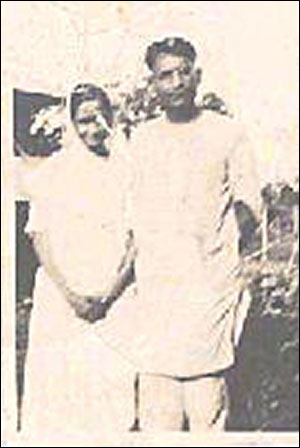

Left: My father, Manilal (Babu), and mother, Sharda (Amma), outside the mill compound. Right: My uncle Vajubhai was courageous and did not fear dying. He was the core engine in dealing with the looters and mob, saving thousands of Hindus and Muslims from the savage mindset. He graduated from Shamadas College of Bhavnagar. He never left Burma (Myanmar) and stayed in Pyapon until he passed away in 1995. He never married and spent his life helping those less fortunate.


Left: Pandit Nehru and Indira Gandhi visiting the mill in 1937. Right: Mahatma Gandhi visiting the mill


Left: My mother, Amma, before the mill was looted. Right: Amma is sewing clothes for the mill workers’ children at the mill. She used to get great fulfillment when the children jumped joyfully with a new dress or shirt. This generosity created outstanding bonds between mill workers and my father.


Left: Amma, with her eldest son, Dhirendrabhai. Right: Babuji was pursuing his leisure activity, gardening.


Left: Babu in his home in Thitan before it was looted. Right: Babu with a British government representative.


Left: Babu with two of his trusted employees, who were instrumental in the mill’s functioning. Right: Home within the mill.


Left: Babu with his team. Right: Other fellow mill workers.


Left: Amma at the mill. Right: Local Burmese people at the mill


Left: The mill after the loot and destruction. Right: Thousands of Indians (Hindus, Jains, and Muslims) were killed by Burmese hooliganism. They were killed by the Burmese “Dhav” (similar to a sword). Hundreds of children in front of my father and uncle’s eyes were snatched from their mother and thrown into nearby water: a sheer tragedy and the result of human madness.



Left and Center: From an unknown newspaper source, Indians walking back to Chitagaon, India. Some walked 400 miles to return to India and some were lucky to have a cart. Right: Our home in Rangoon, after the loot and destruction in Pyapon.
The photocopy letter written in Gujarati:











